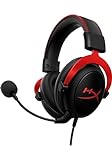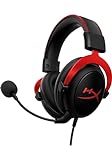HyperX Cloud II vs Sony Inzone H3 - Where are the differences?
Where are the differences?
Let's take a closer look at the differences between the Cloud II* and Inzone H3* gaming headsets.
What year are the headsets from?
The release year is of course important when comparing two headsets. After all, the release date has an influence on the state of the art and usually also affects the price. With the year of publication 2022, the Sony Inzone H3 is newer than the HyperX Cloud II, which is from the year 2015. Which puts 7 years between the two gaming headsets.
Connection options
Let's start with the connectivity options from HyperX Cloud II and Sony Inzone H3. Both give you the option to be wired. A wired connection reduces connection problems and interference, which is an advantage. In return, the cable can possibly interfere.
Radio offers the disadvantage that there can be interference in the verdinbung. In addition, with radio you are usually dependent on a battery, which can also go flat during use. Neither the HyperX Cloud II nor the Sony Inzone H3 can be connected wirelessly. So a wireless connection is not possible. However, often the wireless headsets also offer the additional option to connect the headset via cable.
Cable
Audio
With a driver size of 53 mm, the HyperX Cloud II offers more at this point. The Sony Inzone H3 has a driver size of 40 mm. A larger driver helps reproduce especially low frequencies better and louder. However, it is only one of several factors.
For the HyperX Cloud II the frequency range starts at 15 Hz. For the Sony Inzone H3 the value is at 5 Hz. The end is at HyperX Cloud II for the 25000 Hz and at Sony Inzone H3 for the 20000 Hz. What is really important here is the range between 50 Hz and 10,000 Hz, which is covered by just about every headset nowadays.
Microphone
Of course, both headsets have a microphone built in, which is also adjustable. The microphone can be removed on the HyperX Cloud II when it is not needed. This can be interesting in single mode. It can also be an advantage during transport.
The microphone frequency range of the HyperX Cloud II starts at 15 Hz. The microphone of the Sony Inzone H3 starts at 5 Hz. The microphone of the HyperX Cloud II ends at a frequency range of 25000 Hz. The frequency range from the microphone of the Sony Inzone H3 ends at 20000 Hz.
Volume control and mute
Almost every gaming headset offers the possibility of volume control and mute. So it is also in this case.
Both models offer the option of muting. The HyperX Cloud II is operated via Cable. With the Sony Inzone H3 the control runs per Auricle.
Which headset has more features?
Finally, let's take a look at the equipment. Here, some models have lighting.











